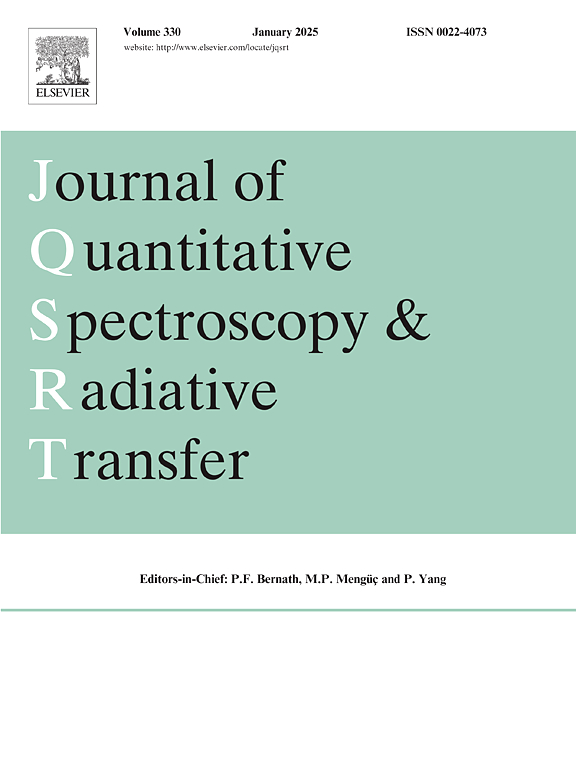Complete set of broadening coefficients and high-order line-shape parameters for N2-broadened CO2 lines, for temperatures ranging from 100 K to 1000 K
IF 2.3
3区 物理与天体物理
Q2 OPTICS
Journal of Quantitative Spectroscopy & Radiative Transfer
Pub Date : 2025-04-25
DOI:10.1016/j.jqsrt.2025.109499
引用次数: 0
Abstract
Broadening coefficients and high-order line-shape parameters, including the speed dependence of the line width, Dicke narrowing and first-order line-mixing parameters, are predicted for N2-broadened CO2 lines over a temperature range from 100 K to 1000 K using requantized molecular dynamics simulations (rCMDS). By employing an intermolecular potential, classical equations of motion, and a requantization procedure, rCMDS enable the calculations of N2-broadened CO2 spectra across a wide temperature range without use of any adjustable parameters. For each considered temperature, line-shape parameters were retrieved from fits of the rCMDS spectra using the Voigt, speed-dependent Voigt, and Hartmann-Tran profiles, with first-order line mixing accounted for. The obtained parameters and their temperature dependences were compared with experimental data at various temperatures showing excellent agreements. We demonstrate that parameters and their temperature dependences obtained at Earth’s atmospheric temperatures cannot be used to deduce with accuracy those at higher temperatures, relevant for studies of exoplanetary atmospheres and combustion media. Comparisons with databases show that several parameters and their temperature dependences need to be updated by incorporating accurate high-temperature data to correctly simulate the absorption spectra of N2-broadened CO2 from low to high temperatures.
温度范围从100k到1000k的n2加宽CO2谱线的全套展宽系数和高阶线形参数
利用定量分子动力学模拟(rCMDS)预测了100 ~ 1000 K温度范围内n2加宽CO2谱线的展宽系数和高阶谱线形状参数,包括谱线宽度、Dicke窄化和一阶谱线混合参数的速度依赖性。通过采用分子间势、经典运动方程和定量过程,rCMDS可以在不使用任何可调参数的情况下,在很宽的温度范围内计算n2展宽的CO2光谱。对于每个考虑的温度,使用Voigt,速度相关Voigt和Hartmann-Tran剖面从rCMDS光谱的拟合中检索线形参数,并考虑了一阶线混合。在不同温度下,将所得参数及其与温度的关系与实验数据进行了比较,结果显示出良好的一致性。我们证明,在地球大气温度下获得的参数及其温度依赖性不能用于准确推断更高温度下的参数,这与系外行星大气和燃烧介质的研究有关。与数据库的比较表明,为了正确模拟n2展宽CO2从低温到高温的吸收光谱,需要结合精确的高温数据来更新几个参数及其温度依赖关系。
本文章由计算机程序翻译,如有差异,请以英文原文为准。
求助全文
约1分钟内获得全文
求助全文
来源期刊
CiteScore
5.30
自引率
21.70%
发文量
273
审稿时长
58 days
期刊介绍:
Papers with the following subject areas are suitable for publication in the Journal of Quantitative Spectroscopy and Radiative Transfer:
- Theoretical and experimental aspects of the spectra of atoms, molecules, ions, and plasmas.
- Spectral lineshape studies including models and computational algorithms.
- Atmospheric spectroscopy.
- Theoretical and experimental aspects of light scattering.
- Application of light scattering in particle characterization and remote sensing.
- Application of light scattering in biological sciences and medicine.
- Radiative transfer in absorbing, emitting, and scattering media.
- Radiative transfer in stochastic media.

 求助内容:
求助内容: 应助结果提醒方式:
应助结果提醒方式:


